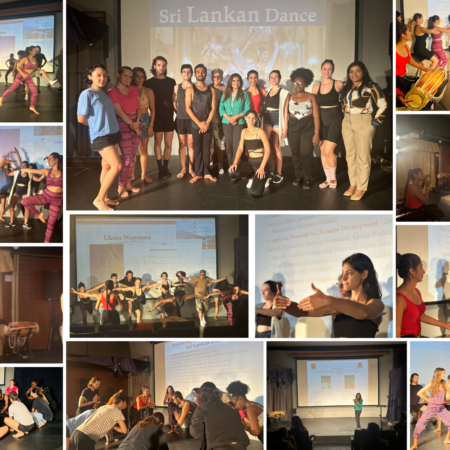ROBIN BARTON
Dinner plate-sized footprints? Check. Warm, basketball-sized lumps of dung? Check. “Yep, we’re definitely on an elephant’s trail,” confirms my guide Pete.
Many people go to Sri Lanka specifically to see elephants; there are about 3000 in the wild. But when you’re cycling around the island’s interior, a 3m-tall Elephas maximus — 5 tonnes of unpredictability — is not something you really want to encounter.
We’ve had an elephant-alert drill for what to do if we cross paths with one: stand stock still and avoiding meeting its eyes, while Pete digs around in the pockets of his combat shorts for some firecrackers. These go off with a bang and, theoretically, scare the beast away … if Pete can find them in time.
While we’re not here for the elephants on this 14-day tour, many of the wonders of Sri Lanka’s archaeological Golden Triangle are on our itinerary: Sigiriya’s citadel; Polonnaruwa, the ruins of a 12th-century city; the Buddhas of Dambulla; Kandy’s Temple of the Tooth; and the tea plantations of Nuwara Eliya.
I’m part of a guided cycling tour: seven strangers, one guide, 10 days of riding, about 500km in total. There are pros and cons of joining a guided cycling trip. The advantage is that a lot of the organisational effort is avoided. Your luggage is taken from one overnight stop to the next, and your guide will know the tried-and-tested cycling routes. The downside is that you don’t get to select all your companions and the experience is fairly prescriptive. You can’t stay an extra day somewhere on a whim, or divert too far from the day’s plan.
That might seem contrary to the cyclist’s instinctive need for freewheeling independence, but on this tour of Sri Lanka’s backroads, Pete is happy to fit in some extra mountain biking for those who need more of a fix, which is how I find myself on an elephant’s trail while my companions are climbing Sigiriya, a 200m-high rock pillar rising out of the jungle with a fortress on top.
In the fifth century, King Dhatusena’s first son, Kasyapa, threatened by the arrival of a legitimate heir, bricked up his father alive in his own palace. Kasyapa’s half-brother, Moggallana, fled to India, while King Kasyapa built a fortress on Sigiriya’s rock pillar. After seven years, Moggallana returned from exile with an army and, in the ensuing battle, Kasyapa’s elephant ran amok, causing confusion in his own ranks and allowing Moggallana to triumph.
Our trip begins on a riverside path of the northern central lowlands near Lake Giritale, as we acclimatise to the humidity. Like the changing rooms at a communal swimming pool, the river is divided into sections. In one languid stretch women are washing their long dark hair. In the next, young men, waist-deep in water, are in discussion. In another section, parents are washing children, the sudsy youngsters springing like frogs from the riverbank into the water as we pass. Downstream is the tractor and water buffalo washing area.
After my excursion with Pete ends not with a bang but a beer, and we catch up on tales of skulduggery from Sigiriya, our group rides onward to Polonnaruwa, fuelled by lemony, finger-sized bananas. Here the ruins of the 12th-century city are being reclaimed from the jungle, although monkeys — shy grey langurs and bolder macaques — still gambol on bulbous stupas (funerary domes made from millions of bricks). It’s worth hiring a local guide to explain the buildings and temples since signposting is thin on the ground; they’ll likely have a bicycle, which is the best way to get around the vast site.
Stonework of a spiritual nature is found in Dambulla’s mountainside caves, which contain colossal statues of Buddha dating from the second century.
But I’ve been waiting to get into hill country, south of the Triangle, where the world’s finest Ceylon teas are harvested, and the climate is cooler. Our first stop in Sri Lanka’s highlands is the city Kandy, and to get to Kandy means, for those who wish, descending 23km down the Knuckles mountain range into the island’s cultural hub.
Again, there’s just one volunteer — me. The first portion of the ride runs through tea plantations, peppered by tea pickers wearing technicolour saris. It was an old planter who first showed Pete some routes through the plantations — this is the value of local knowledge.
Soon the trail rejoins the road and we race against the setting sun around forested mountainsides and through one-street villages, bunny-hopping over 1m-wide potholes, speeding past fume-belching buses and tuktuks. Bats as large as tea towels flap along the valley beside us. We make the climb into Kandy in the smoggy orange glow of twilight.
Kandy is famous for its Temple of the Tooth. The 18th-century building houses one of Buddhism’s most sacred relics, a canine tooth of Buddha, which arrived in Sri Lanka for safekeeping in the third century. Every year, in July, the tooth is paraded through Kandy on an elaborately decorated elephant, but there are three pujas (blessings) daily at the temple.
The ride continues south to Nuwara Eliya, a colonial hill station at 2000m. The rose beds, mist, post office and Hill Club (jackets and ties please, gentlemen) could be an English village, circa 1930. English names abound, such as Horton Plains, Elgin Falls, Gregory’s Lake. Then we descend from the highlands all the way to the south coast, hitting the beach after 500km and 238 bottles of water (and uncounted Three Coins beers after each day).
I never did see a wild elephant, but being on a bike got us close to Sri Lanka’s local culture, even if that included the group of children waiting at the top of a pass with homemade bows and arrows, picking off the stragglers.






















